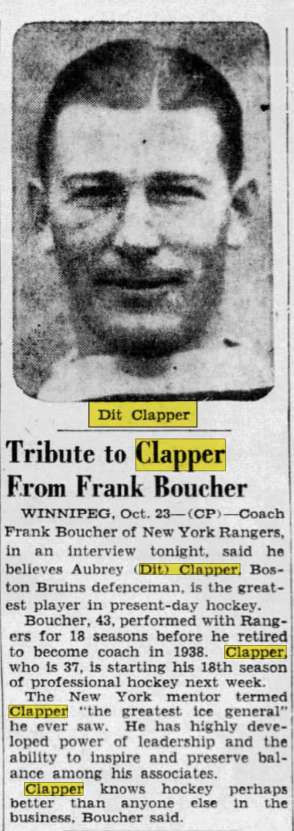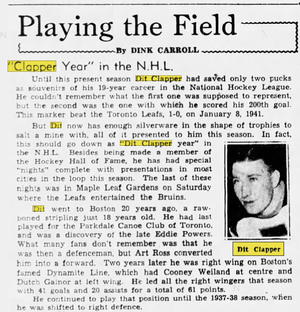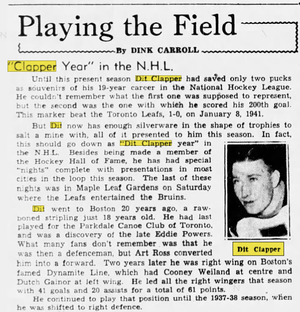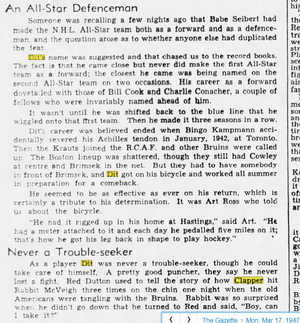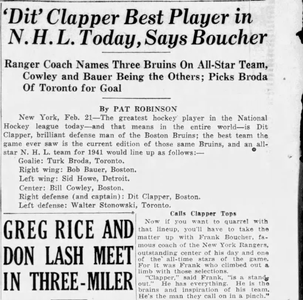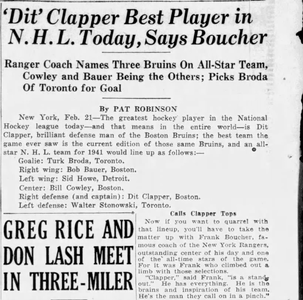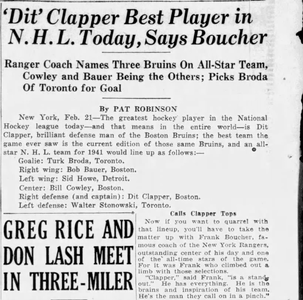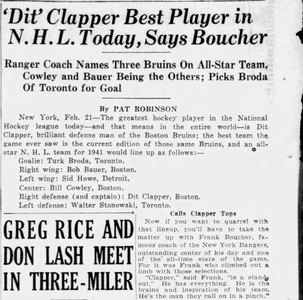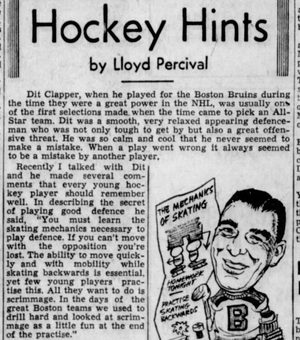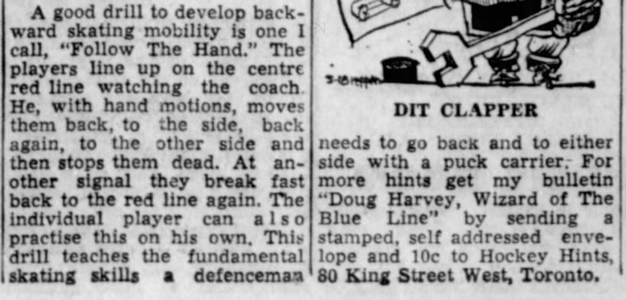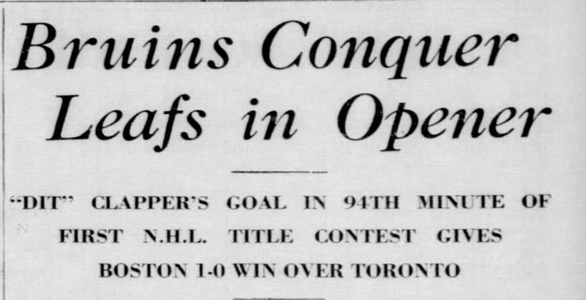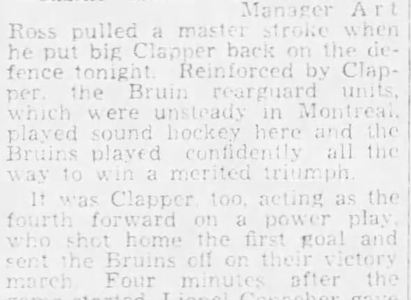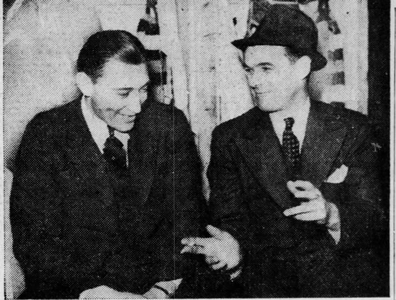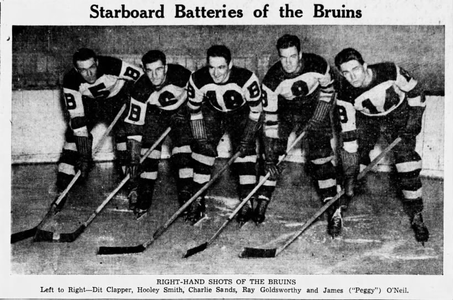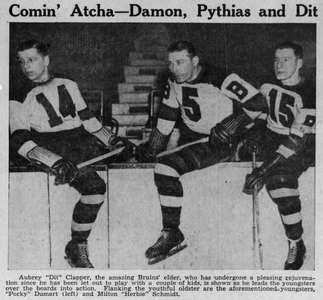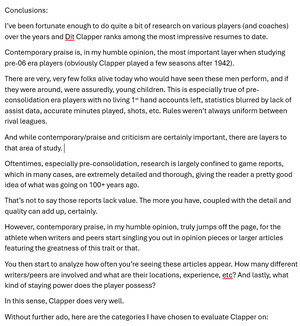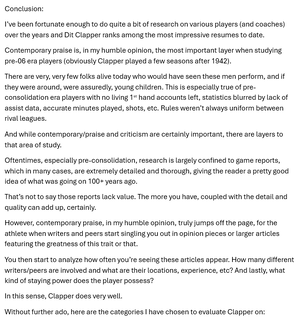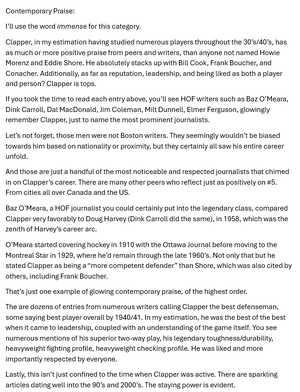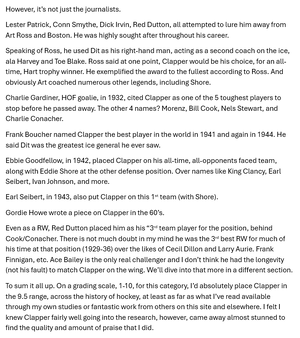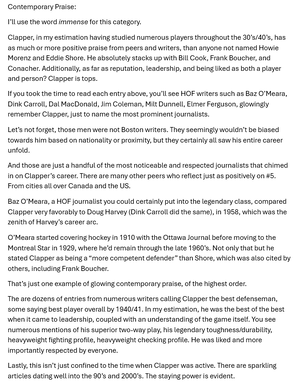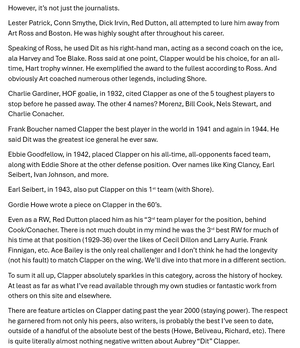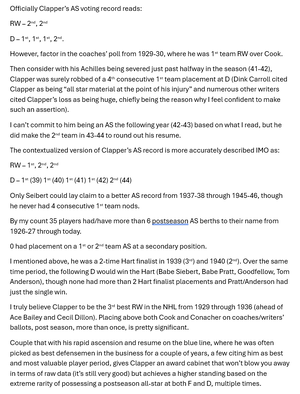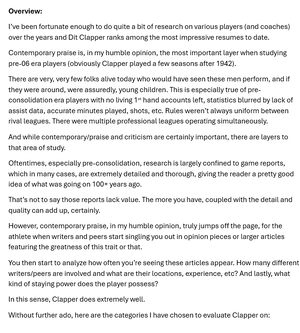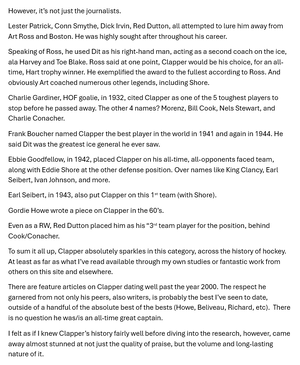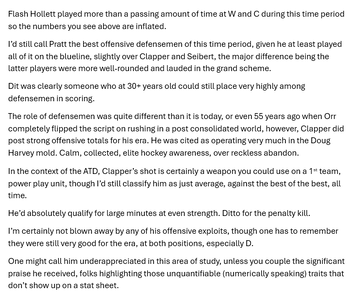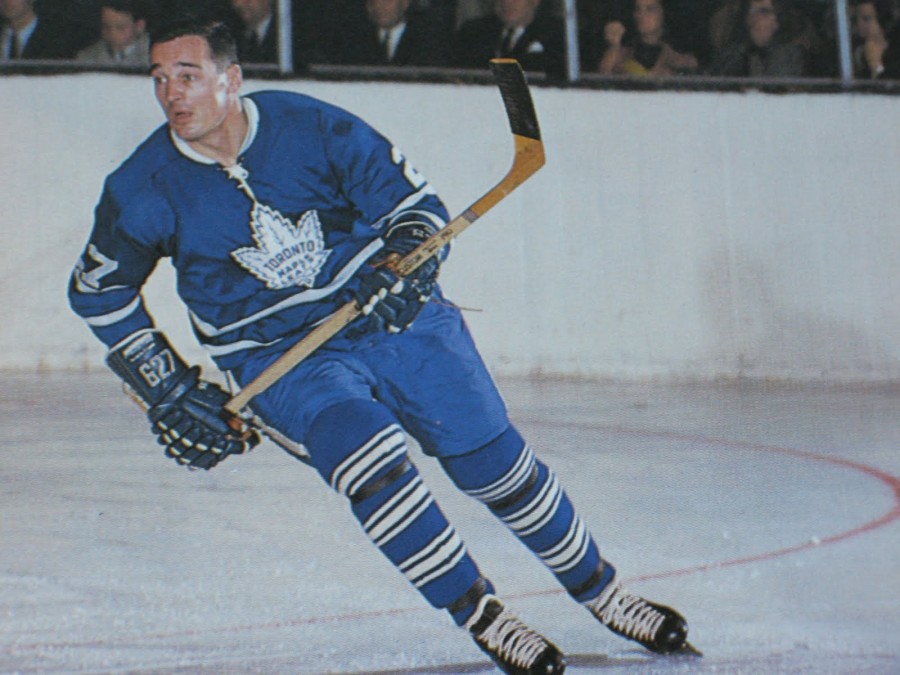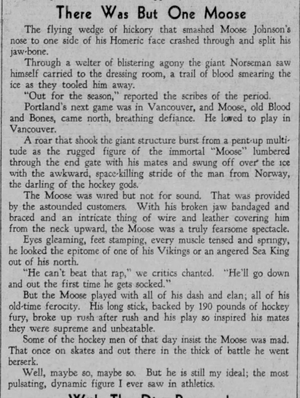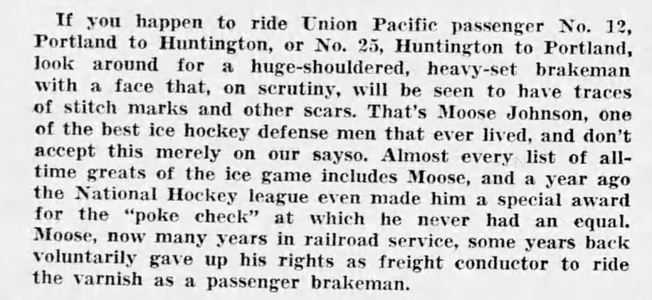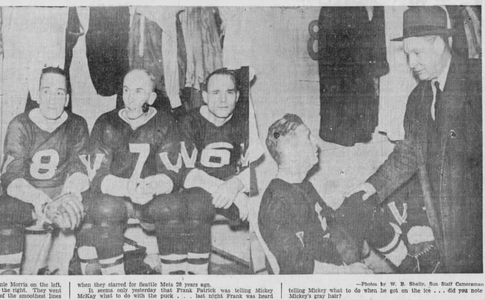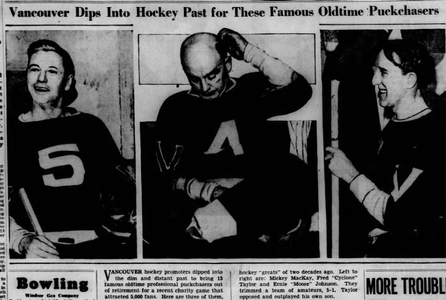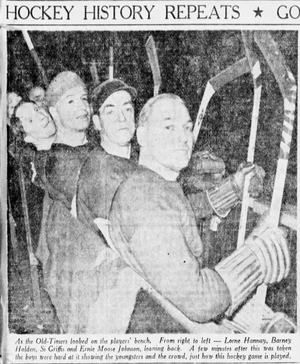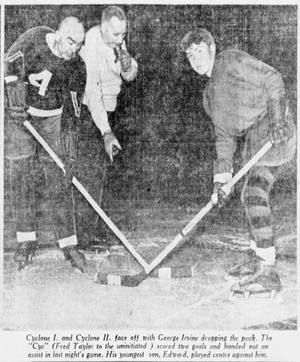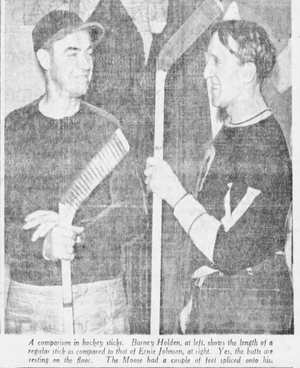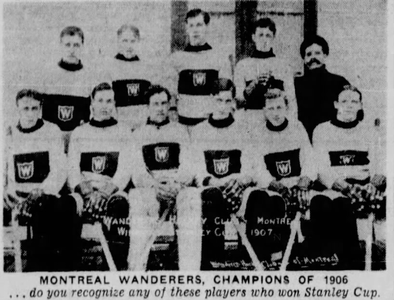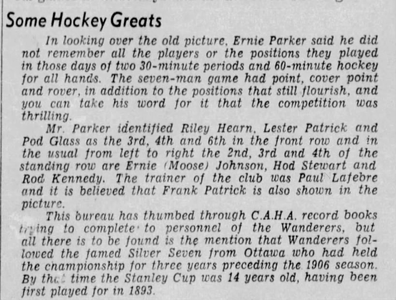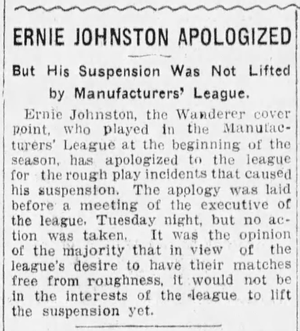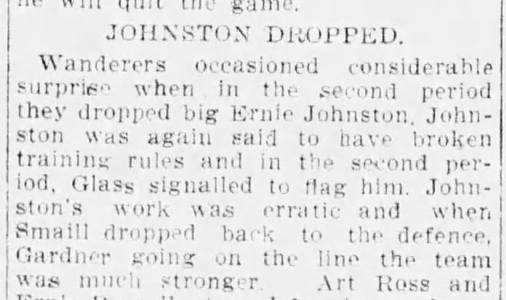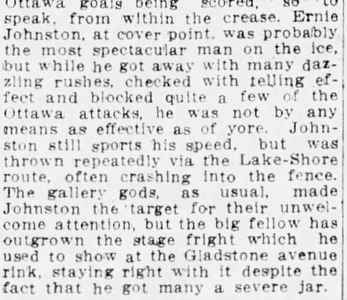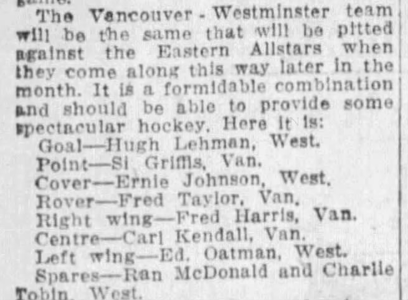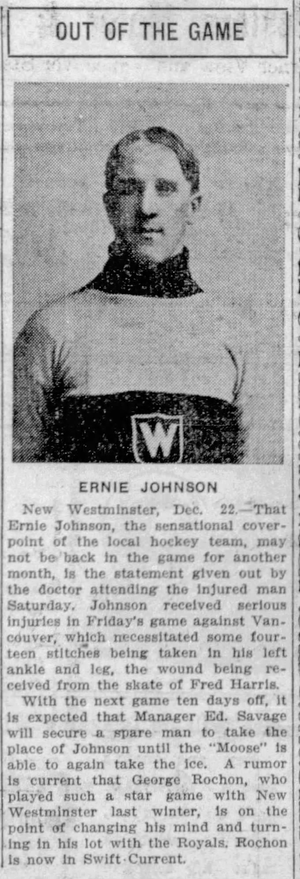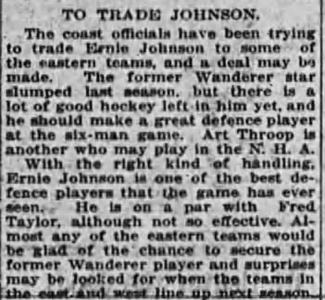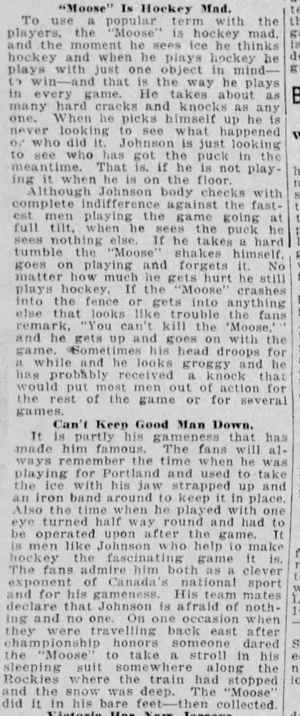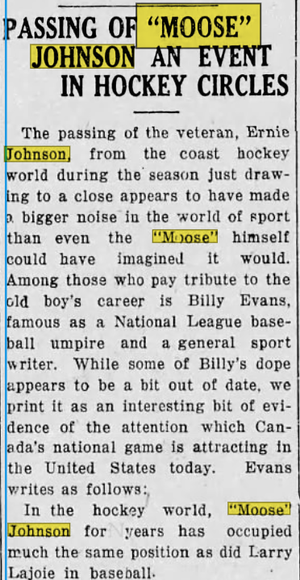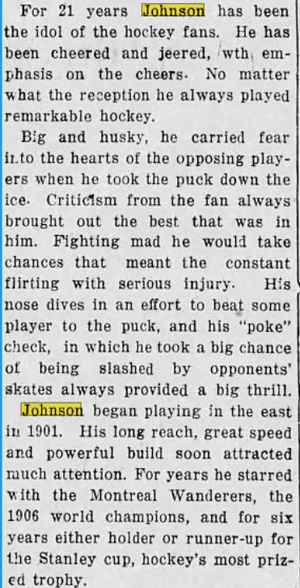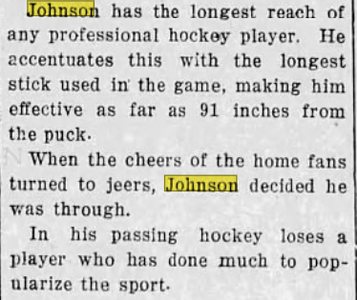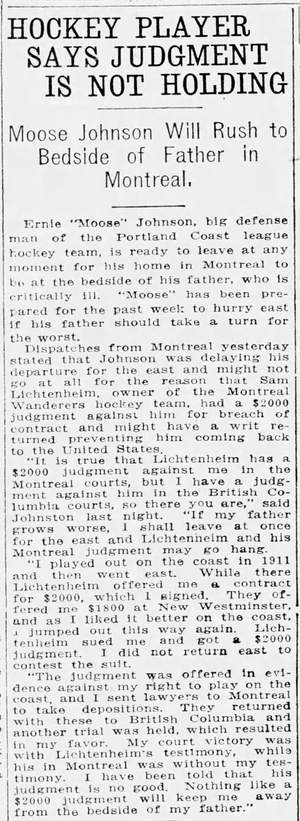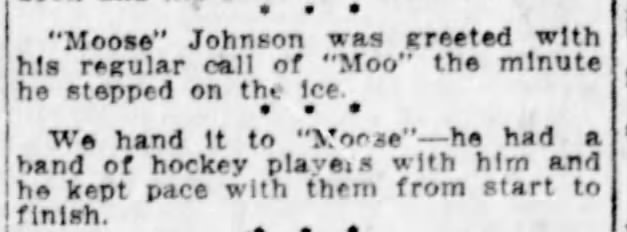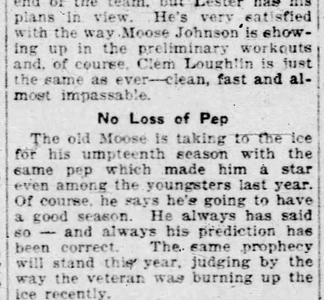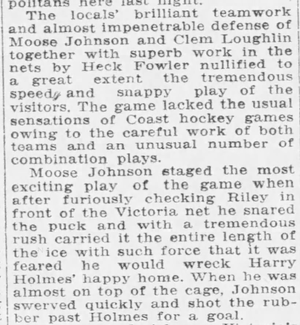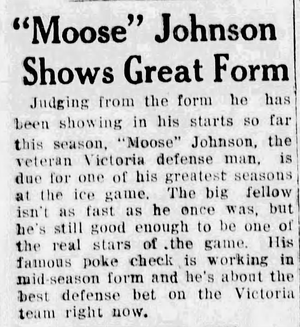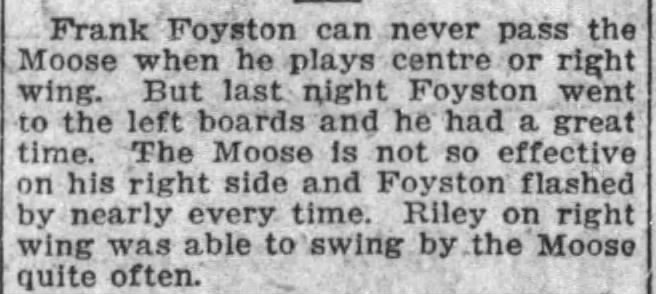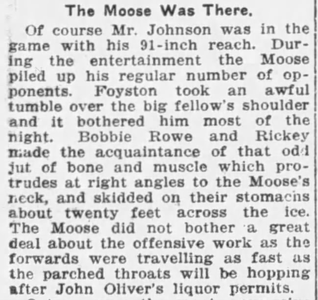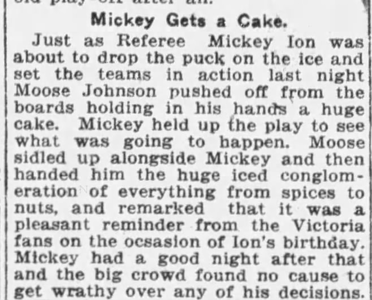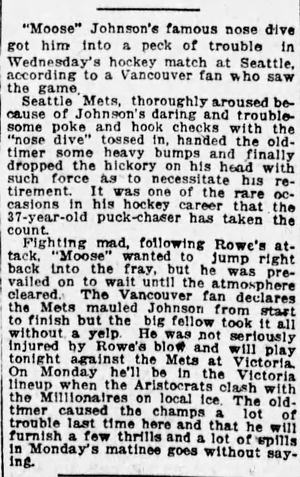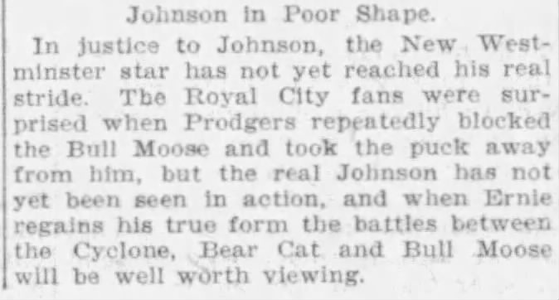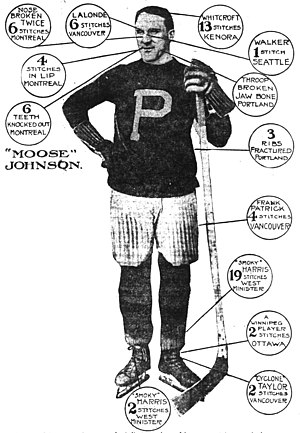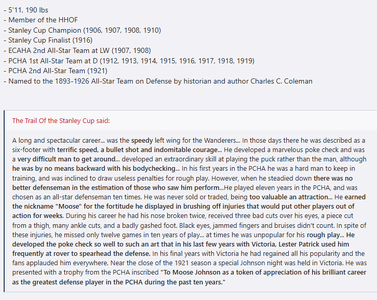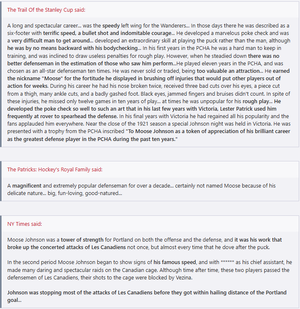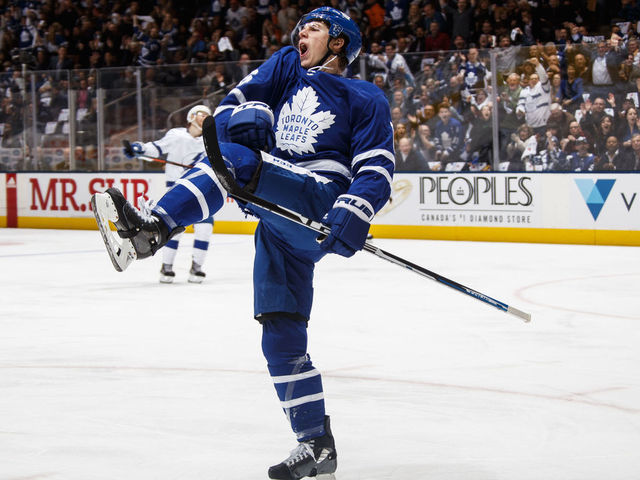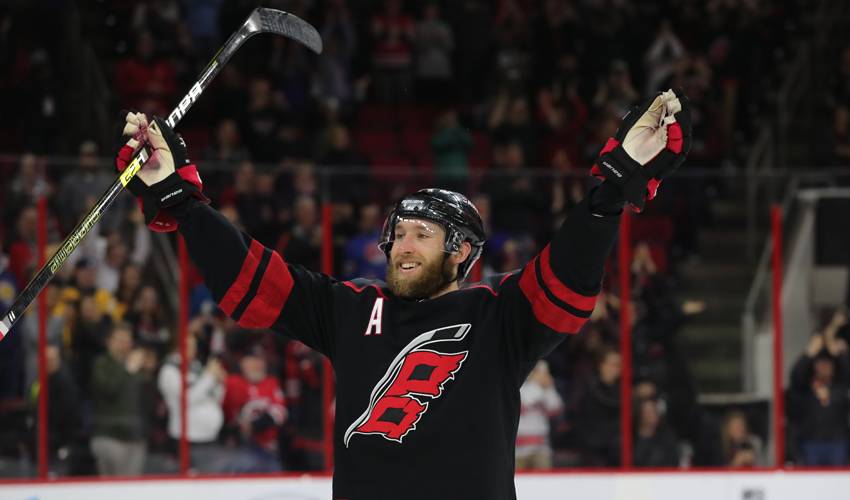Aubrey "Dit" Clapper - D/RW - Boston Bruins - 1927-1947
Below is my career overview through many hours of newspaper researching with publishers plus on newspapers.com.
Entries are chronologically dated:
Boston, Massachusetts • Wed, Jan 2, 1929Page 16
Boston, Massachusetts • Tue, Mar 19, 1929Page 26
Springfield, Massachusetts • Wed, Mar 20, 1929Page 7
Boston, Massachusetts • Thu, Mar 28, 1929Page 26
(1928-29), Clapper was used mostly as a wing but did see some action on the blueline in relief.
Boston, Massachusetts • Fri, Mar 29, 1929Page 30
Boston, Massachusetts • Wed, Oct 23, 1929Page 23
Preview of the 29-30 season stating Clapper appears ready to ascend into star territory. He would.
Ottawa, Ontario, Canada • Fri, Dec 13, 1929Page 10
Detailed description of Clapper goal shows he used opposing players as screen to score.
Ottawa, Ontario, Canada • Fri, Dec 13, 1929Page 32
Boston, Massachusetts • Fri, Dec 13, 1929Page 41
Boston, Massachusetts • Mon, Dec 30, 1929Page 17
Springfield, Massachusetts • Thu, Jan 2, 1930Page 16
Feature on Dutch Gainor actually sheds a lot of light on just how rapid Clapper's rise in ability/output was been from 28-29 to the 29-30 campaign.
Springfield, Massachusetts • Fri, Jan 3, 1930Page 25
Clapper scouting report calls him "A rugged, sturdy player, he has tremendous strength in his wrists and can drive the pucik like a shot from a gun. It was his low, raking drives that flicked at lightning speed across the goalers feet that earned him so many goals earlier in the season."
Boston, Massachusetts • Tue, Jan 8, 1929Page 27
Clapper was allowed away from the team for a game due to his fiancee's serious illness, which she would pass away from later in the month (a few entries below this)
Regina, Saskatchewan, Canada • Wed, Jan 15, 1930Page 15
In season scouting report of sorts by a Western paper no-less. Called "standout performer" in his new position. Heavy shot cited and he seems to have been the focal point of the attack.
Windsor, Ontario, Canada • Mon, Jan 20, 1930Page 17
Slick pass from Clapper to Weiland ends up being GW. Dit also scored a pair of goals.
Montreal, Quebec, Canada • Wed, Jan 22, 1930Page 18
Montreal, Quebec, Canada • Mon, Jan 27, 1930Page 16
Boston, Massachusetts • Mon, Jan 28, 1929Page 21
The Boston Globe Archive
Clapper's fiancee passed away during the 29-30 season due to complications from an illness.
Montreal, Quebec, Canada • Mon, Feb 3, 1930Page 15
Toronto, Ontario, Canada • Wed, Feb 5, 1930Page 8
Lester Patrick and Rangers offered huge sum to get Clapper in 1930.
Windsor, Ontario, Canada • Mon, Feb 17, 1930Page 17
Springfield, Massachusetts • Thu, Feb 20, 1930Page 21
One of the standout players in the NHL. Has a right hand shot that "few, if any rival wings, can approach." Clapper rated among the stars of hockey.
Springfield, Massachusetts • Wed, Feb 19, 1930Page 22
Vancouver, British Columbia, Canada • Tue, Mar 4, 1930Page 12
Boston, Massachusetts • Wed, Mar 12, 1930Page 27
More citations of Clappers fast shots.
Montreal, Quebec, Canada • Wed, Mar 19, 1930Page 16
Boston, Massachusetts • Thu, Mar 20, 1930Page 25
"Dead-Eye" Dit Clapper, the greatest straight-away marksman in professional hockey."
Kingston, Ontario, Canada • Thu, Mar 27, 1930Page 10
Citation of Ching Johnson having his jaw broken in a head on collision w/Clapper
Boston, Massachusetts • Fri, Mar 28, 1930Page 41
Clapper's lighting shot cited again plus evidence of him PK'ing.
Montreal, Quebec, Canada • Fri, Apr 4, 1930Page 20
The Gazette Archive
This is big for Clapper. Even in a SCF series ending loss to the Morenz led Habs, Clapper was cited as spectacular, claiming a place as "one of the greatest wing players in hockey." And this is the Montreal Gazette, so you can throw any bias out the window.
Ottawa, Ontario, Canada • Wed, Aug 20, 1930Page 9
Ottawa Citizen reviewing the 29-30 campaign of Clapper. Officially listed as a defensemen interestingly, but obviously played RW, cited as being a "spectacular goal-getter" and "prime favorite in Boston."
Toronto, Ontario, Canada • Wed, Nov 12, 1930Page 8
Edmonton, Alberta, Canada • Wed, Nov 12, 1930Page 16
Montreal, Quebec, Canada • Wed, Nov 19, 1930Page 18
Chicago, Illinois • Wed, Nov 26, 1930Page 21
Ottawa, Ontario, Canada • Fri, Nov 28, 1930Page 28
Yonkers, New York • Fri, Dec 12, 1930Page 31
Saskatoon, Saskatchewan, Canada • Fri, Dec 19, 1930Page 24
Diagram showing a popular combination between Clapper and Weiland.
Vancouver, British Columbia, Canada • Fri, Dec 19, 1930Page 28
Montreal, Quebec, Canada • Fri, Dec 26, 1930Page 12
Clapper hat trick + beautiful jab/devastating right cross to knock down Kilera in a fight.
Boston, Massachusetts • Fri, Jan 30, 1931Page 31
Boston, Massachusetts • Wed, Mar 25, 1931Page 15
Clapper takes would Battleship Leduc in a big collision.
Springfield, Massachusetts • Wed, Mar 25, 1931Page 18
Montreal, Quebec, Canada • Mon, Mar 30, 1931Page 18
Springfield, Massachusetts • Fri, Nov 6, 1931Page 35The Morning Union Archive
The Morning Union Archive
Clapper already noted as established star in NHL, possessing one of the hardest right handed shots.
Boston, Massachusetts • Wed, Nov 18, 1931Page 21
Boston, Massachusetts • Wed, Dec 16, 1931Page 26
Boston, Massachusetts • Mon, Dec 21, 1931Page 17
Springfield, Massachusetts • Tue, Jan 5, 1932Page 14
Charlie Gardiner names the 5 toughest players he's ever had to stop. Clapper is in some elite company.
Nels Stewart
Morenz
Bill Cook
C. Conacher (has hardest shot according to Gardiner)
Dit Clapper
Gardiner calls Clapper a "sweet all-around player and a good shot, too. I'd pick him as just a little above Ebbie Goodfellow of the Falcons for general effectiveness around the net."
Montreal, Quebec, Canada • Mon, Jan 18, 1932Page 16
Montreal paper calls Clapper the Bruins' most deadly marksman, and in this game was their most effective.
Moncton, Moncton Parish, New Brunswick, Canada • Wed, Nov 23, 1932Page 2
Winnipeg, Manitoba, Canada • Tue, Feb 28, 1933Page 15
Springfield, Massachusetts • Sun, Mar 26, 1933Page 19
Windsor, Ontario, Canada • Mon, Jan 28, 1935Page 23
Calgary, Alberta, Canada • Mon, Mar 25, 1935Page 5
Moncton, Moncton Parish, New Brunswick, Canada • Mon, Mar 25, 1935Page 2
Boston, Massachusetts • Mon, Dec 30, 1935Page 10
Boston, Massachusetts • Wed, Jan 15, 1936Page 20
Victor Jones of the Globe states: Clapper "playing one of the best all-around wings I have ever gazed upon."
"On the very first rush, Clapper, who not only covered his own right wing all night, but also roamed to the other flank, stole the puck from Charlie Conacher, eluded Bob Davidson with some blazing stick handling, and put the Bruins two goals up while the Bruins were shorthanded."
Boston, Massachusetts • Tue, Mar 3, 1936Page 21
North Bay, Ontario, Canada • Fri, Mar 13, 1936Page 7
"Dit likes to play up front but he is also a smart defenseman and has filled Eddie Shore's berth more than once. His 194 pounds, packed on a six-foot-two-inch frame, give him plenty of brawn to step into incoming forwards."
Calgary, Alberta, Canada • Thu, Apr 2, 1936Page 6
Toronto rumor mill alleging Busher Jackson for Clapper was discussed/offered?!?
Fredericton, York, New Brunswick, Canada • Fri, Oct 23, 1936Page 2
Clapper scouting report from 1936 (still a F at this point)
Boston, Massachusetts • Tue, Jan 5, 1937Page 20
Vic Jones calling some of the Boston faithful loud mouths.
Cites Clapper as being "for years Clapper has been rated one of the most valuable players in the league and I have seen him play some games on one leg which other players couldn't match with two."
Toronto, Ontario, Canada • Sat, Feb 13, 1937Page 10
Art Ross emphatically stating that Clapper is not for sale, at any price.
Montreal, Quebec, Canada • Mon, Feb 22, 1937Page 14
Boston, Massachusetts • Wed, Feb 24, 1937Page 23
Winning goal was a Clapper SH variety (5th goal in 6 games).
Boston, Massachusetts • Sat, Mar 20, 1937Page 9
Montreal, Quebec, Canada • Mon, Mar 22, 1937Page 16
Montreal, Quebec, Canada • Fri, Mar 26, 1937Page 12
The great Dal MacDonald of the Montreal Gazette giving a firsthand account of Clapper's move back to D late in the 1936-37 season.
"For one who hasn't played defense for 10 years, Clapper proven that he has a remarkable memory of the finer points of this position. Dit came to Boston Tigers, then the farm club of the Bruins, 10 years ago as a defenseman and was converted into a right winger by Art Ross. Mr. Clapper, like the elephant, apparently never forgets. Certainly tonight as he steadied down the Boston defense he looked like an old hand at the job.
Eddie Shore couldn't have done better."
From the game report same paper:
"Reinforced by Clapper, the Bruin rearguard units which were unsteady in Montreal, played sound hockey here and the Bruins played confidently all the way to win a merited triumph.
It was Clapper too, acting as the 4th F on a power play, who shot home the first goal and sent the Bruins on their victory march."
Saskatoon, Saskatchewan, Canada • Wed, Nov 3, 1937Page 14
Boston, Massachusetts • Mon, Nov 15, 1937Page 8
First game of the 37-38 campaign, Clapper on D. "Clapper will do at defense." Also called a "riot, knocking down 2 Rangers who tried to stop him."
Boston, Massachusetts • Tue, Dec 7, 1937Page 21
The Boston Globe Archive
A fan tried to sue Clapper for 10K for being stuck by a puck shot by Dit,
Brooklyn, New York • Fri, Feb 18, 1938Page 6
Boston, Massachusetts • Fri, Feb 18, 1938Page 21
Boston, Massachusetts • Thu, Feb 24, 1938Page 8
Boston Globe writer Vic Jones speaks to the ability of Clapper to protect his teammates.
Detroit, Michigan • Mon, Dec 19, 1938Page 13
Clapper beauty of a GW goal described
Toronto, Ontario, Canada • Tue, Dec 20, 1938Page 11
Boston, Massachusetts • Tue, Dec 20, 1938Page 18
Springfield, Massachusetts • Wed, Jan 25, 1939Page 16
Fantastic overview on Clapper during the 38-39 season.
Noted to "have dropped into the defensive post like a hand fits into an old glove. With his tremendous physical bulk and strength, his ability to hit a stunning body check, to break quick on attack and set up plays, he quickly became one of the most valuable players on the entire Bruin rear guard."
Edmonton, Alberta, Canada • Thu, Jan 26, 1939Page 7
Edmonton paper calls Clapper "one of the greatest hockey players of all time" during the musings of hockey rumor mill. It was suggested Clapper was headed to NY......but that obviously did not happen.
Boston, Massachusetts • Sat, Feb 4, 1939Page 7
Baz O'Meara, the "hockey encyclopedia of Montreal" put Clapper and Babe Siebert on this AS team late in the 38-39 campaign over players like Earl Seibert and Art Coulter.
Portland, Maine • Mon, Feb 13, 1939Page 14
Evening Express Archive
Clapper and Shore co-won the Bruins MVP award for the 38-39 season.
Toronto, Ontario, Canada • Sat, Feb 18, 1939Page 5
Clapper's scoring from the blueline is stellar
Calgary, Alberta, Canada • Fri, Mar 3, 1939Page 7
Western paper calls Clapper "almost a dead cinch for an all-star spot."
"Dit, who once played right wing on the famous dynamite line, has been winning huzzas all season for his work at stopping them coming in and getting past them when he starts traveling out."
Boston, Massachusetts • Mon, Mar 20, 1939Page 7
The Boston Globe Archive
Clapper playing with a broken toe, has a 4 point night, starring for the Bruins.
Moncton, Moncton Parish, New Brunswick, Canada • Sat, Mar 25, 1939Page 6
Bill Hutchinson opinion piece regarding the AS teams for the 38-39 season.
He states "An all-Boston defense appeals to this writer strongly. They play the game the way we like it. Shore and Clapper know how to bust them or steer them to a corner and nobody can deny they know what it is all about when it comes to ripping into enemy territory when goals are needed. Clapper's wing experience has not been forgotten and Shore always was an artist at starting scoring threats.
Boston, Massachusetts • Sat, Mar 25, 1939Page 6
Boston, Massachusetts • Wed, Mar 29, 1939Page 10
Boston, Massachusetts • Thu, Mar 30, 1939Page 20
Vic Jones in an opinion piece, decries fighting, and notes that most hockey players are crappy "fighters". Clapper, however, led a group of players who buck that general trend in late 30's hockey. Dit was cited along with Bill Cook, Earl Seibert, Nels Stewart, and Lionel Conacher, along w/a few others who could actually fight on skates.
Boston, Massachusetts • Mon, Apr 3, 1939Page 8
Clapper knocked another player out of a game (Shibicky) w/a body check.
Boston, Massachusetts • Mon, Apr 17, 1939Page 4
Clapper doing some fine defensive work in the SCF clinching game
Wild fact. Both Clapper and Brimsek missed the Cup ceremony because they got into the showers too quickly! See picture below.
New York, New York • Mon, Apr 17, 1939Page 126
Great action shot of Clapper assisting on a Mel Hill goal during the SCF.
Fredericton, York, New Brunswick, Canada • Tue, Oct 17, 1939Page 2
Clapper announced Captain by Art Ross before 39-40 season.
Saint John, Saint John, New Brunswick, Canada • Fri, Oct 20, 1939Page 8
Clapper listed as 211 lbs prior to the 39-40 season.
Toronto, Ontario, Canada • Sat, Oct 28, 1939Page 12
Toronto Star refers to Clapper as a "great defenseman now." prior to 39-40 season.
Boston, Massachusetts • Wed, Nov 15, 1939Page 20
Toronto, Ontario, Canada • Sat, Dec 2, 1939Page 36
Scouting report/bio on Clapper
Toronto, Ontario, Canada • Fri, Dec 22, 1939Page 11
Toronto speaks to Clapper's defensive brilliance.
Boston, Massachusetts • Sat, Dec 23, 1939Page 4
Outstanding Clapper overview by Gerry Moore of the Globe.
Moncton, Moncton Parish, New Brunswick, Canada
1940 Scouting report cites Clapper as being one of the most versatile players of all time. His size, strength, heavy bodychecking, and speed were cited and his puck carrying abilities meshed very well with Art Ross' style of play.
Boston, Massachusetts • Sat, Feb 3, 1940Page 4
Boston, Massachusetts • Tue, Feb 6, 1940Page 18
Ottawa, Ontario, Canada • Wed, Feb 7, 1940Page 11
Boston, Massachusetts • Wed, Feb 28, 1940Page 10
Boston, Massachusetts • Wed, Mar 13, 1940Page 21
Clapper becomes 1st Bruin to win team MVP in unanimous vote.
Victoria, British Columbia, Canada • Wed, Mar 13, 1940Page 13
Western paper saying Clapper "has played better than ever at the blueline for the Bruins, since Eddie's departure. He also took home team MVP honors, after sharing it with Shore the previous season.
Toronto, Ontario, Canada • Wed, Mar 13, 1940Page 16
Chicago, Illinois • Sat, Mar 16, 1940Page 2
Illinois paper picks Clapper as 1st team D for 1939-40 stating "There is no questioning the selection of Dit Clapper. He not only is the season's top defense man but the most valuable player in the NHL as well."
BIG praise from a Blackhawks writer.
Boston, Massachusetts • Mon, Mar 18, 1940Page 11
Brooklyn, New York • Tue, Mar 19, 1940Page 12
Brooklyn NY paper citing Clapper as the only Bruin defender capable of being a threat carrying the puck, possessing "savvy" and is "in a class with Bauer/Cowley (at carrying the puck).
Moncton, Moncton Parish, New Brunswick, Canada • Thu, Mar 21, 1940Page 2
Clapper repeating as the 1st team AS by a "tremendous vote" commending his "all-around work as captain and rusher with the Bruins after the departure of Eddie Shore.
I feel strongly by this point in time, Clapper has ascended to best Dman in the world. Some considered him the best player period.
Victoria, British Columbia, Canada • Thu, Mar 21, 1940Page 11
Lewiston, Maine • Fri, Mar 29, 1940Page 12
Clapper toughness noted.
Ottawa, Ontario, Canada • Tue, Apr 16, 1940Page 16
Feature on Clapper and Goodfellow being as rugged and tough as they come in the NHL. Conn Smythe apparently wanted Clapper more than any Dman of that time period. Obviously a trade never transpired.
Montreal, Quebec, Canada • Fri, Apr 19, 1940Page 31
Dick Irvin of Montreal wanted to acquire Clapper in 1940
Montreal, Quebec, Canada • Wed, Apr 24, 1940Page 25
Baz O'Meara stating that there is virtually no chance the rumors of Clapper being available are true. Trading Clapper would bring the roof in on Art Ross
Toronto, Ontario, Canada • Wed, Aug 7, 1940Page 13
Conn Smythe revisiting his efforts to try and lure Clapper away from Boston. Said Toronto would have "10 pennants dangling from the roof instead of one."
Moncton, Moncton Parish, New Brunswick, Canada • Sat, Nov 2, 1940Page 2
Cited as Canadian Press pick for an AS berth the previous 2 years, turning in "peak performances" of his career on the blueline.
Ottawa, Ontario, Canada • Wed, Nov 6, 1940Page 14
Clapper's coolness on the ice cited.
Saint John, Saint John, New Brunswick, Canada • Mon, Jan 20, 1941Page 10
Telegraph-Journal Archive
HJ Osborne feature on Clapper's 200th, stating Clapper "is looked on as one of the greatest of all-time stars in NHL warfare."
Toronto, Ontario, Canada • Mon, Jan 20, 1941Page 11
The Toronto Star Archive
Passaic, New Jersey • Wed, Feb 5, 1941Page 17
NJ paper feature on the importance of Clapper.
"It's hard to imagine them (rest of star players) achieving such a record without a big fellow named Aubrey Clapper in the line up every game.
"Clapper is still about the most important single individual on the Bruins team. Once a star forward, he's now the mainstay of a defense that's one of the best in the NHL, He still has the speed to go down and score a goal in an occasional "clutch."
Ottawa, Ontario, Canada • Wed, Feb 5, 1941Page 11
Clapper intercepting pass and going the length of the rink to score OT goal.
He was presented his 200th goal puck before the game by Ottawa mayor Stanley Lewis
Springfield, Massachusetts • Fri, Feb 21, 1941Page 18
Frank Boucher calls Clapper best player in the world, 1941 (he'd later repeat this a few years down the road).
Bayonne, New Jersey • Tue, Feb 25, 1941Page 8
The Bayonne Times Archive
"I rate him (Clapper) even above Eddie Shore."
Niagara Falls, Ontario, Canada • Mon, Mar 3, 1941Page 10
Sports Editor Bill Gaynon of Ontario paper cites Clapper as generally the name most thrown out in 1941 for best defensemen in the NHL
Niagara Falls, Ontario, Canada • Mon, Mar 3, 1941Page 10
Really neat 1 on 1 interview with Clapper, a number of topics discussed.
Montreal, Quebec, Canada • Fri, Mar 21, 1941Page 16
"Clapper, captain of the Bruins, has been recognized as the league's outstanding defensemen, and the selectors showed this again by giving him 29 of a possible 30 votes."
Boston, Massachusetts • Sat, Mar 29, 1941Page 8
Montreal, Quebec, Canada • Tue, Apr 1, 1941Page 19
The Sports Fan Cup (sounds like a fan vote for most popular player in the league) awarded by Bus Johnston saw Clapper edge out Syl Apps with 66,910 votes to 61,566.
Windsor, Ontario, Canada • Mon, Apr 14, 1941Page 18
The Windsor Star Archive
Doug Vaughan, of the Windsor Star speaks to the dominance of the 1940-41 Bruins.
Calls Clapper "the best rearguard in the business today." Brimsek and Clapper sparked the Bruins in the SCF win vs Toronto w/Cowley missing time.
Boston, Massachusetts • Mon, Apr 14, 1941Page 8
Ottawa, Ontario, Canada • Sat, Apr 19, 1941Page 31
Incredible piece on Clapper's leadership and contributions to the Bruins.
Bill Cowley states:
"I thought Clapper was a cinch to win the Hart Trophy. He played marvelous hockey for us this year. If there was any one man more responsible than another for our Stanley Cup victory, I think Clapper is that man. Dit's help to Bruins doesn't stop at being a great player. He's a grand fellow, looked up to by all the players and one of the finest leaders I have ever seen."
Much more written below...
North Bay, Ontario, Canada • Sat, Nov 15, 1941Page 8
Boston, Massachusetts • Wed, Dec 3, 1941Page 23
Dit Clapper winning a face-off as a defensemen.
North Bay, Ontario, Canada • Fri, Dec 5, 1941Page 10
North Bay Nugget Archive
Clapper wins the Sports Fan popularity contest and is presented with trophy by Bus Johnston in the Montreal forum. The voting tally is listed about 6-7 entries above this one.
Boston, Massachusetts • Tue, Dec 9, 1941Page 32
Clapper is the feature and coverman for the 1941-42 NHL hockey guide publication.
Boston, Massachusetts • Tue, Jan 13, 1942Page 24
Portsmouth, New Hampshire • Wed, Jan 21, 1942Page 8
The Portsmouth Herald Archive
Clapper was a heavyweight fighter throughout his career.
Detroit, Michigan • Sun, Jan 25, 1942Page 11
Huge praise for Clapper from Ebbie Goodfellow who picks his All Time-Opponent Team (players he's faced)
At defense, Goodfellow contends that Clapper, of the present Bruins, is as good if not better than any of the old stars. "There's a defensemen who is as smooth as they come," Goodfellow said of his Boston rival and that's praise indeed.
Atlantic City, New Jersey • Thu, Jan 29, 1942Page 11
Kitchener, Ontario, Canada • Sat, Jan 31, 1942Page 8
Waterloo Region Record Archive
Clapper named assistant manager (coach)
"Listing hockey's leading players, book them in the order of: Clapper, Apps, Schmidt, Heller, Hextall, Syd Howe, Mush March, Goodfellow, Tommy Anderson and Earl Seibert."
Boston, Massachusetts • Sat, Jan 31, 1942Page 6
Winnipeg, Manitoba, Canada • Mon, Feb 2, 1942Page 14
The Winnipeg Tribune Archive
Details of the Achilles injury
Moncton, Moncton Parish, New Brunswick, Canada • Mon, Feb 2, 1942Page 8
Bill Hutchinson, sports editor notes that Clapper's loss for Boston is a big one, saying "the big defenseman probably is Boston's most important player."
Toronto, Ontario, Canada • Mon, Feb 2, 1942Page 12
The Toronto Star Archive
In depth look at Clapper's injury with quotes from players.
Ottawa, Ontario, Canada • Mon, Feb 2, 1942Page 19
Famous Ottawa Journal writer Bill Westwick notes Clapper's immense importance to Boston, especially during their last SC run.
"...the big rearguard who in a quiet way has done a lot more coaching of the Boston Club that he's ever been publicly credited with.
And even in the twilight of an illustrious major league career, Clapper still rates with the greatest."
Calgary, Alberta, Canada • Tue, Feb 3, 1942Page 10
Ebbie Goodfellow picks his All-Opponents team (seemingly best players he ever faced) and Dit Clapper is on the 1st team, along with Shore, over both King Clancy and Ching Johnson. Remember, you also had Earl Seibert, Lionel Conacher, Babe Seibert, and Art Coulter who didn't make EG's list.
Calgary, Alberta, Canada • Tue, Feb 3, 1942Page 10
The Calgary Albertan Archive
Harry Scott of Calgary highlighting the severe Achilles injury Clapper sustained midway through the 1941-42 season.
I think this is an important juncture in Clapper's career, at least as far as his time as a defenseman goes. The fact that he sustained such a rough injury, at his age (34), in 1942 with less modern methods of surgery/healthcare, etc, and then managed to return to full health and play essentially 4 more seasons, while making his way back onto the postseason AS team in 1943-44, speaks to the character of Clapper and ability.
At this point in time he's already played longer than the vast majority of NHL'ers ever, and was almost universally considered the best defenseman in the world, and some considered him the most valuable player period. You can see the Hart voting finishes in 1940 (3rd) and 41 (2nd) as a testament to that value.
Biddeford, Maine • Fri, Feb 6, 1942Page 6
Bill King of the Biddeford Maine paper says Clapper's injury is the biggest reason for Boston's losses.
Boston, Massachusetts • Tue, Feb 24, 1942Page 20
The Boston Globe Archive
Clapper was a tough SOB. Roughly a month after having his Achilles cut, he's walking around without crutches or a cane.
"The team can't help getting a lift from the presence of Clapper, who was always an inspirational leader in his active role as captain."
Boston, Massachusetts • Wed, Feb 25, 1942Page 20
Clapper acting coach while out w/the Achilles injury.
Montreal, Quebec, Canada • Mon, Mar 9, 1942Page 17
Big praise from Dink Carroll of the Montreal Gazette, wondering if the Achilles injury to Clapper would be the end of his career, in a "Playing The Field" piece.
States "Only the greatest players last that long (15 years) and Clapper was certainly one of them. Up to the time of his injury he was still All-Star material."
Boston, Massachusetts • Sat, Mar 14, 1942Page 6
Clapper's leadership noted and work behind the bench sparking Bruins.
Boston, Massachusetts • Mon, Mar 23, 1942Page 10
Clapper coaching the Bruins to a playoff victory. Aggravated his injured achilles tendon by jumping up and down on the bench when the winning goal was scored.
Also cited as masterminding the team from the bench perfectly.
Montreal, Quebec, Canada • Thu, Oct 22, 1942Page 25
Detroit, Michigan • Fri, Oct 30, 1942Page 27
Detroit previewing the return of Clapper from serious injury. A favorite in Detroit, his return is celebrated. Also was called a "brilliant wingman" by old timers.
Toronto, Ontario, Canada • Sat, Nov 28, 1942Page 18
Nice Clapper feature in the Toronto paper cites Clapper as most durable player in NHL with a long career of star power.
Montreal, Quebec, Canada • Mon, Nov 30, 1942Page 18
Early season 42-43 season, it seems like Clapper is already returning to his pre-injury form.
North Bay, Ontario, Canada • Thu, Dec 3, 1942Page 18
"For years, Clapper has been one of the most popular players in the big-time loop-and small wonder. Not only is he ace-high on performance, but he rates as one of the most sportsmanlike players in the circuit. Never in one season has he spent an hour on the penalty bench."
Boston, Massachusetts • Wed, Dec 16, 1942Page 25
This is Clapper's first season after returning from the Achilles injury. Noted by Jack Adams to be having a "good season" but Hollett, Cowley and Brimsek the best Bruins to date. His heavy checking was still on point it seems.
In game report notes it was a hard checking game and best contest at the Garden to date, with Clapper handing out 4 body checks that wowed the crowd, smacking down Don Grosso, Syd Abel, Jimmy Orlando, and Bill Quackenbush to the ice."
Hamilton, Ontario, Canada • Thu, Dec 17, 1942Page 24
Walter McMullen, sports editor details Clapper's career and standing all time ending w/ "so when compiling your list of the greats of hockey, place the name Mr. Clapper at the top, or thereabouts."
Montreal, Quebec, Canada • Sat, Dec 26, 1942Page 12
Dink Carroll citing Clapper "is back to his old self" in the early portions of his first season since having Achilles sliced through less than a year ago.
Boston, Massachusetts • Sat, Feb 13, 1943Page 6
Boston, Massachusetts • Tue, Mar 16, 1943Page 24
Bangor, Maine • Wed, Oct 13, 1943Page 8
Commercial Archive
Feature by Bill King on Clapper's career.
Boston, Massachusetts • Sun, Oct 31, 1943Page 28
Clapper and Rocket had a fight in 1943
Toronto, Ontario, Canada • Thu, Nov 4, 1943Page 16
Andy Lytle recalling the great Moose Johnson. saying "he had the fire and zest of King Clancy in the body of Dit Clapper"
Boston, Massachusetts • Wed, Nov 17, 1943Page 18
Moncton, Moncton Parish, New Brunswick, Canada • Thu, Nov 18, 1943Page 8
Springfield, Massachusetts • Fri, Dec 17, 1943Page 25
Boston, Massachusetts • Wed, Dec 22, 1943Page 6
Windsor, Ontario, Canada • Tue, Jan 4, 1944Page 19
Earl Seibert picks Clapper and Shore for his 1st team D on his all-time opponents team.
Boston, Massachusetts • Wed, Jan 26, 1944Page 9
Ottawa, Ontario, Canada • Fri, Feb 25, 1944Page 18
"Dit is practically an institution with the Bruins, one of those players in a million. No player with whom I have ever been associated has given me more pleasure from a manager's point of view.
But you come to Clapper and you have a great forward when he was up front. You put him back on the defense and he continues to star. And all the way he has been of the best influences any hockey club ever had in its ranks. The older players like him; the young ones admire him.
If I had to name an all-star all-time Hart trophy winner I'd name Dit. He typifies the true winner of the award."
-Art Ross
Montreal, Quebec, Canada • Wed, Mar 1, 1944Page 16
Recalling how Clapper was instrumental in Maurice Richard learning the lesson of keeping your head up.
Winnipeg, Manitoba, Canada • Fri, Oct 20, 1944Page 16
Incredible late career retrospective by Herb Manning of the Winnipeg Tribune.
Some key highlights:
"Eddie Shore was a dynamic, colorful figure with Boston's Bruins and he wound up finally with the title of Mr. Hockey-a super-giant among the giants of the slippery game.
But Clapper is colorful too, and a more efficient craftsman than Shore, a better team player, in the estimation of hockey men who know him.
Frank Boucher cites Clapper as "greatest ice general he ever saw, with highly developed powers of leadership and the ability to inspire and preserve balance among his associates. His outstanding characteristic is his talent for leadership."
Windsor, Ontario, Canada • Tue, Oct 24, 1944Page 21
Late career feature on Clapper
Ottawa, Ontario, Canada • Tue, Oct 24, 1944Page 10
Frank Boucher calls Clapper best player in game in 1944 and the "greatest ice general he ever saw".
Hamilton, Ontario, Canada • Fri, Oct 27, 1944Page 28
The Hamilton Spectator Archive
Preseason write up on Clapper for the 44-45 season
Springfield, Massachusetts • Tue, Dec 19, 1944Page 12
Springfield, Massachusetts • Fri, Feb 9, 1945Page 14
Clapper picks his All-Time Hockey Team.
New York, New York • Sun, Feb 25, 1945Page 68
"Red Dutton, league prexy, has written a book in which he lists an all-time all-star team..."right wing, Clapper"
Since being moved to the back-lines, the 6-foot-2, 195 pounder has reached new heights. For the past eight seasons he has been among the leading defensemen, his speedy skating still counts heavily. Despite the rough checks he dishes out, Clapper is thoroughly a gentleman, universally well liked and a ball-player's ballplayer."
Detroit, Michigan • Tue, Mar 6, 1945Page 16
Leo McDonald of Detroit Times calls Clapper an "all-time, all-great" player in this piece in which Clapper picks his all time team. Nice read.
Portland, Maine • Fri, Feb 9, 1945Page 15
Clapper picking his AS team...."However, few pink experts would omit the name of Aubrey Dit Clapper from any all-star aggregation...Clapper stepped into Eddie Shore's famous skates as a defenseman where he has been consistently tops."
Montreal, Quebec, Canada • Thu, Mar 8, 1945Page 16
Montreal paper calls Clapper "one of the all-time defense greats of the NHL."
Barre, Vermont • Tue, Mar 27, 1945Page 2
Windsor, Ontario, Canada • Fri, Oct 26, 1945Page 27
Bradford, Ontario, Canada • Wed, Mar 6, 1946Page 2
The Witness Archive
Boston, Massachusetts • Fri, Sep 6, 1946Page 18
The Boston Globe Archive
Recalling the one time in Clapper's career where he lost his composure and socked newly appointed president of the league, Clarence Campbell (then a ref) during a game in 1937. After KO'ing Dave Trottier, Campbell made a snide remark to Clapper during the brawl and got a punch for it. Campbell admitted his role in the punch and there was no ill-will between them.
Ottawa, Ontario, Canada • Fri, Dec 27, 1946Page 18
Boston, Massachusetts • Sun, Feb 9, 1947Page 33
Art Ross cites Clapper's ability to learn and absorb lessons early in his career as one of his biggest assets in becoming a HOF caliber player.
Ottawa, Ontario, Canada • Wed, Feb 12, 1947Page 18
Fantastic end of career look at Clapper by Ottawa writer Tommy Shields. You'll see his retirement was not only celebrated greatly in Boston, it was a league wide affair with each team giving a special presentation to Clapper for his career achievements.
Also, a heroic story mentioned where Clapper helped save the lives of 3 of his friends when their boat flipped over and he had to swim half a mile to shore, to retrieve a 2nd boat.
Boston, Massachusetts • Wed, Feb 12, 1947Page 18
Boston, Massachusetts • Thu, Feb 13, 1947Page 19
Some great photos of Clapper's jersey that ended up in the HOF. More hardware presented. At the end of the article you can see the remaining schedule for "Clapper night".
Boston, Massachusetts • Thu, Feb 13, 1947Page 11
Rome, New York • Tue, Feb 18, 1947Page 10
Daily Sentinel Archive
Clapper's fighting ability cited
Hammond, Indiana • Thu, Feb 20, 1947Page 11
Detroit, Michigan • Fri, Feb 21, 1947Page 16
Really neat picture of Clapper accepting a silver bowl from the Jack Adams, on behalf of the Detroit Red Wings during his final season in the league.
Montreal, Quebec, Canada • Mon, Mar 3, 1947Page 18
Clapper being presented with silver tray during his final game in Montreal.
Montreal, Quebec, Canada • Mon, Mar 17, 1947Page 18
Fantastic career overview on Clapper by Dink Carroll, another citation of his generalship of the ice being made by someone who witnessed him firsthand. Dink will later compare his generalship and IQ to that of Harvey in 1961.
Toronto, Ontario, Canada • Sat, Nov 1, 1947Page 13
Toronto, Ontario, Canada • Sat, Dec 11, 1948Page 18
Boston, Massachusetts • Sun, Mar 23, 1952Page 88
The Boston Globe Archive
More 1st hand accounts of Clapper being the policeman for Boston's smaller players.
Montreal, Quebec, Canada • Fri, Dec 4, 1953Page 28
The Gazette Archive
Longtime Bruin team physician, Dr Kelley. cites Shore, Clapper and Schmidt as the most durable and rugged players over his tenure (now 1953).
Montreal, Quebec, Canada • Fri, Dec 24, 1954Page 34
Feature for series being done by Red Fischer, written by Clapper, remembering his 200th goal.
Vancouver, British Columbia, Canada • Fri, Nov 2, 1956Page 20
More testaments to how well liked Clapper was/is. Plus this entry and next speak to his AS picks and thoughts on current players. You can tell he knows hockey given the players he put forth.
Vancouver, British Columbia, Canada • Fri, Nov 2, 1956Page 27
Great interview w/Clapper.
Vancouver, British Columbia, Canada • Fri, Nov 2, 1956Page 8
Montreal, Quebec, Canada · Monday, April 07, 1958
Wonderful analysis and comparison between Clapper and Doug Harvey by the all time great writer Baz O'meara who's career started in 1910 (Ottawa Journal) and later spent 30+ years at the Montreal Star (1929 through late 60's). He has some of the most in depth opinion pieces I've seen in all my research over the years.
Main points:
Clapper was a standout at controlling the game from the blueline ala Harvey
Cited as being a touch faster, a heavier body checker than Harvey
Caught Rocket Richard w/his head down in an early career game
Cited as not being overshadowed by Eddie Shore and called a "more competent defender" than his former teammate. This tracks with Clapper calling Shore the best offensive defensemen he ever saw in the entry just above this.
Montreal, Quebec, Canada • Wed, Jul 13, 1960Page 35
Another man w/a lot of hockey knowledge, Elmer Ferguson, with a fantastic overview of Clapper's longevity, skills/abilities, ability to pair well with numerous teammates at F and D.

Moncton, Moncton Parish, New Brunswick, Canada • Sat, Mar 18, 1961Page 13
The Times-Transcript Archive
Another profile by another long time writer Lloyd Percival talking about Clapper's ability to control the play, remain calm and collected on the back end. 2 way play cited.
Montreal, Quebec, Canada • Tue, Jun 6, 1961Page 22
Boston, Massachusetts • Fri, Sep 18, 1964Page 15
Feature on Bobby Bauer highlights how Clapper, not Shore, was the policeman for Boston.
Toronto, Ontario, Canada • Wed, Jan 4, 1967Page 39
Boston, Massachusetts • Sun, Feb 16, 1969Page 82
Toronto, Ontario, Canada • Fri, Jan 20, 1978Page 17
Toronto, Ontario, Canada • Mon, Jan 23, 1978Page 8
Boston, Massachusetts • Sat, Jan 21, 1978Page 15
Regina, Saskatchewan, Canada • Fri, Oct 21, 1983Page 19
This article in response to Harry Sinden allowing Guy Lapointe to wear the retired #5 jersey of Clapper, which didn't sit well with a lot of folks, including Clapper's family.
Vancouver, British Columbia, Canada • Mon, May 11, 1998Page 30
Vancouver, British Columbia, Canada • Sun, Apr 4, 1999Page 52
Toronto, Ontario, Canada • Tue, Jan 11, 2005Page 57
Milt Schmidt would pick Dit Clapper (along with Orr) over Eddie Shore, Ray Bourque or any other Boston great to play in a game 7, tie game, 1 minute left.
North Bay, Ontario, Canada • Sat, Aug 25, 2007Page 39
Boston, Massachusetts • Sun, Mar 6, 2016Page C2

